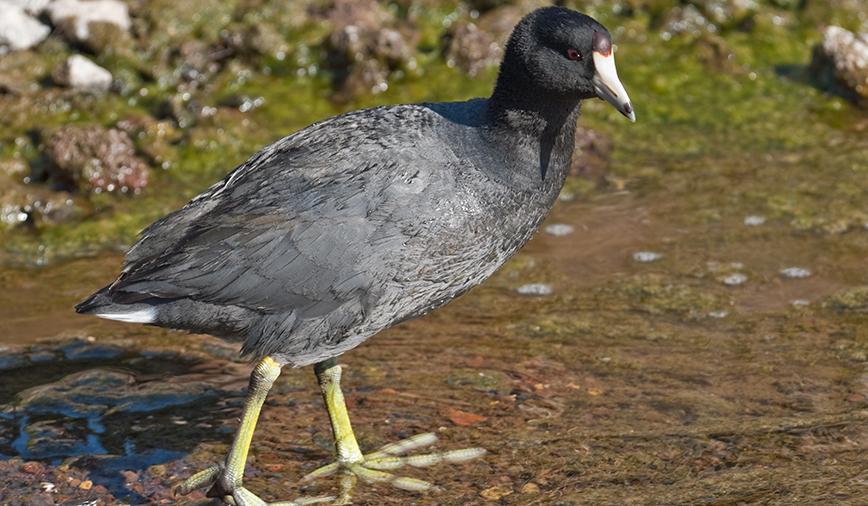You just gotta love a coot. An American coot, that is.
American coots are water birds that many folks would classify as ducks. After all, they do look like dark-colored ducks—from a distance. But if you take the time to observe more closely, you’ll notice that the bill is a) white, with a dark vertical mark near the tip and b) conical, not flattened, in shape. It’s more chicken like than duck like.
Furthermore, coots don’t quack like ducks, they kuk. A raspy, kuk-kuk, kuk-kuk-kuk—almost like the cluck of a chicken. A chicken with a sore throat. Hmm.
Finally, coots most certainly do not swim like ducks. Ducks glide smoothly thru the water, driven by two webbed feet ideally suited to aquatic conveyance. The coot? Well, coots swim all right, but instead of webbing their feet have fleshy projections called lobes. The result is a bird that more or less chugs through the water, its head reaching forward with each push of a foot below. Picture how a chicken’s head moves as it walks on land, and you’ll have the movement of a coot on water.
Coots actually are not ducks—or chickens—at all, but members of the rail family. Rails are seasonal inhabitants of area marshes; they are sometimes heard but seldom seen. Virginia rails, for example, nest at St. Charles Park District’s Campton Hills Park, but are rarely detected by passing visitors. Cryptically colored, rails blend in well with their surroundings. They also have thin, laterally compressed bodies that allow them to pass between the stems and stalks of marshy vegetation with barely a ripple.
But every family has its exceptions and, among rails, it’s the American coot. Variously described as “conspicuous,” “gregarious” and “demonstrative,” coots often leave little doubt as to their presence. They feed by dabbling at the water’s surface as well as diving below in search of aquatic plants and other items like crustaceans and insects, even stealing a meal on occasion from other waterfowl. When the time comes to leave an area, coots commence with much flapping and scrambling, splattering and splashing their way across the water before finally taking flight.
Why all this talk about coots? They are, after all, a migratory species that spends summers here but typically winters farther south. Well, at least two coots have decided to stay a while and enjoy this wild ride of a winter we’re having. They’ve been sighted recently among the Canada geese that congregate in the open water above the St. Charles dam.
If you’d like to try your hand at coot watching, you might wish to wait until spring, when their numbers will be plentiful throughout our area. Or, you can bundle up now and head out for an unfrozen stretch of water; the Fox River near a dam and the lakes at Fermilab are good bets. Look for flocks of waterfowl, then scan the individuals in search of a duck-like bird about 15 to 16 inches in length—notably smaller than our ubiquitous mallard ducks—with a white bill, black head, dark-gray body and dark, reddish-brown eyes. The coot’s distinctive white bill and bobbing swim motions will soon give it away. Then sit back and enjoy the fun!
These upcoming nature and gardening events are brought to you by the St. Charles Park District:
Frog Monitoring Training
Learn about the frogs of Kane County, then volunteer to visit a local wetland at least three times between March and June and identify frogs by their calls. Recordings of various calls will be provided. From 9 a.m. to noon Saturday at Pottawatomie Community Center in St. Charles. No fee, no registration necessary.
Restoration Work Party
Brush cutting and stacking will be the main activity, 9 a.m. to noon Saturday at Norris Woods. Norris Woods is located on the east side of St. Charles on 3rd Ave. behind Bethlehem Lutheran Church. For more information, please contact natural areas manager Denis Kania at 630-513-4367.
The Natural Garden Lunch & Learn: Annuals
Look forward to spring and fresh, beautiful annuals at this program, offered in partnership with The Natural Garden, St. Charles. Susan Wysock will lead a presentation on new arrivals and old classics that are great additions to a perennial garden. Lunch provided. Fee is $20 for St. Charles residents, $30 for nonresidents. Class meets Wednesday, Feb. 13, 11:30 a.m.-1:00 p.m. at The Natural Garden. Registration deadline is Friday, Feb. 8.
Pam Otto works for the St. Charles Park District and can be reached at 630-513-4346. For information about how to register for these or any St. Charles Park District programs, please call 630-513-6200.

